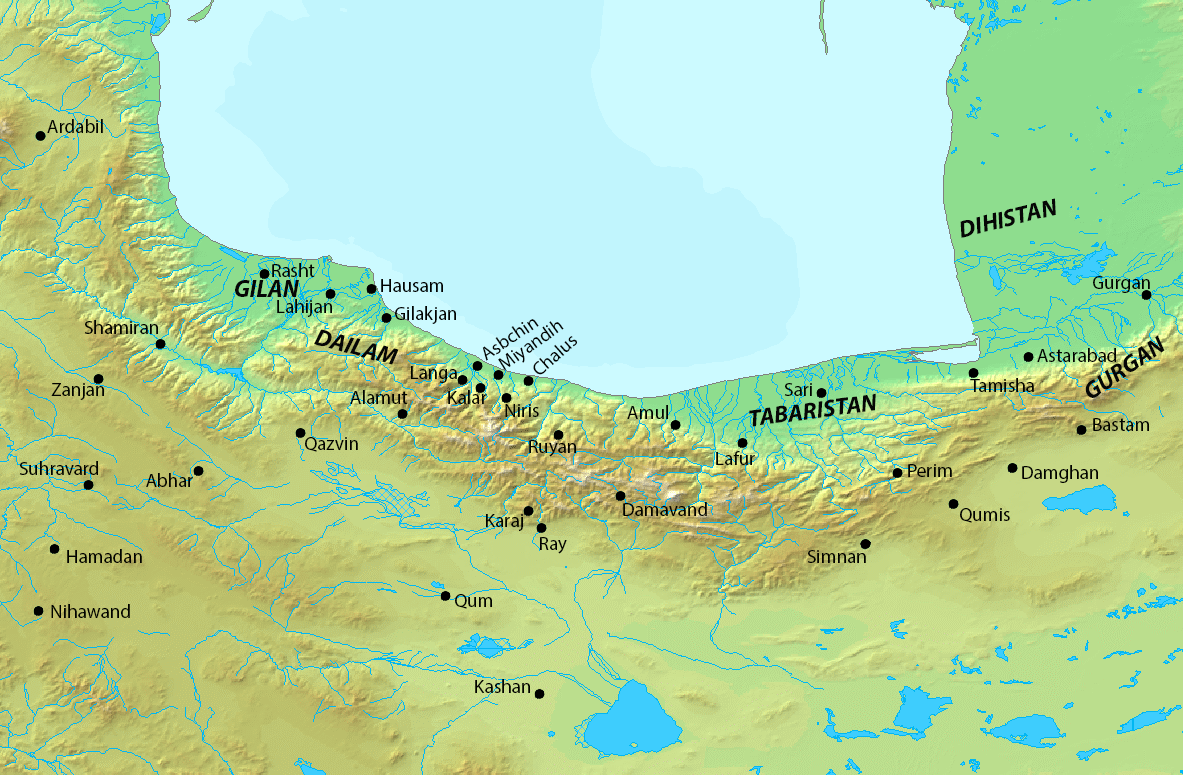|
Harusindan
Harusindan was the third king of the Gilites, ruling briefly in 921. He was the son of Tirdadh, who was the first king of the Gilites during the 10th century, but later died and was succeeded by another Gilite named Lili ibn al-Nu'man, who was from another clan. Harusindan also had a sister who married a Dailamite nobleman named Ziyar, and together they had a son named Mardavij, who would later create the Ziyarid dynasty The Ziyarid dynasty () was an Iranian peoples, Iranian dynasty of Gilaki people, Gilaki origin that ruled Tabaristan from 931 to 1090 during the Iranian Intermezzo period. The empire rose to prominence during the leadership of Mardavij. After his .... After the death of Lili in 921, Harusindan ascended the Gilite throne. A group of Gilites and Dailamites shortly planned to kill the Alid ruler Abu Muhammad Hasan ibn Qasim. However, Abu Muhammad eventually found out about the conspiracy, and had Harusindan killed, who was shortly succeeded by the Farawand ch ... [...More Info...] [...Related Items...] OR: [Wikipedia] [Google] [Baidu] |
Mardavij
Mardavij ( Gilaki/, meaning "man assailant") was an Iranian prince, who established the Ziyarid dynasty, ruling from 930 to 935. Born to a Zoroastrian family native to Gilan, Mardavij sought to establish a native Iranian Zoroastrian empire akin to the Sasanian Empire that had been conquered in the 7th century by the Rashidun Caliphate and subsequently ruled by Muslims. He first started his career by joining the army of his kinsman Asfar ibn Shiruya. Mardavij, however, later betrayed and killed him, conquering much of Jibal. He then set out to conquer Hamadan, Dinavar and Isfahan from the Abbasid Caliphate, and thereafter declared himself king of Iran, making Isfahan his capital. He then defeated the Daylamite military leader Makan ibn Kaki, and conquered Tabaristan in 932. By 934, his authority was acknowledged as far as Shiraz and Ahvaz. However, his goal of recreating the Iranian Empire was ruined when he was murdered by his own Turkic slaves in 935. Background Mardavij ... [...More Info...] [...Related Items...] OR: [Wikipedia] [Google] [Baidu] |
Lili Ibn Al-Nu'man
Lili ibn al-Nu'man, also known as Lili ibn Shahdust, was the leader of the Shahanshahvand clan, and also ruled as the second king of the Gilites, ruling from the early 10th-century to 921. He served in high offices under his overlord the Zaydids. In 921, he invaded the territories of Samanids, conquering Damghan, Nishapur and Merv. He was, however, defeated and killed by a Samanid army under Abu'l-Fadl al-Bal'ami and Simjur al-Dawati. Lili was succeeded by Harusindan Harusindan was the third king of the Gilites, ruling briefly in 921. He was the son of Tirdadh, who was the first king of the Gilites during the 10th century, but later died and was succeeded by another Gilite named Lili ibn al-Nu'man, who was f ..., who was a Gilite from another clan. Sources * *C. E. Bosworth "Bal'ami, Abu'l-Fazl Mohammad." ''Encyclopedia Iranica.'' 23 January 2014. *Treadwell, Luke.Simjurids" ''Encyclopaedia Iranica.'' Ed. Ehsan Yarshater. Columbia University. Retrieved 8 May 2012. {{end ... [...More Info...] [...Related Items...] OR: [Wikipedia] [Google] [Baidu] |
Tirdadh
Tirdadh was the first king of the Gilites, ruling during an unknown date between the 9th and 10th-century. He was succeeded by Lili ibn al-Nu'man. Tirdadh had a son named Harusindan Harusindan was the third king of the Gilites, ruling briefly in 921. He was the son of Tirdadh, who was the first king of the Gilites during the 10th century, but later died and was succeeded by another Gilite named Lili ibn al-Nu'man, who was f ..., who would later succeed Lili ibn al-Nu'man as the new ruler of the Gilites. Sources * 10th-century deaths 10th-century Iranian people Year of birth unknown Gilaki people {{iran-royal-stub ... [...More Info...] [...Related Items...] OR: [Wikipedia] [Google] [Baidu] |
Ziyarid Dynasty
The Ziyarid dynasty () was an Iranian peoples, Iranian dynasty of Gilaki people, Gilaki origin that ruled Tabaristan from 931 to 1090 during the Iranian Intermezzo period. The empire rose to prominence during the leadership of Mardavij. After his death, his brother Vushmgir and his Samanid Empire, Samanid allies led the dynasty in wrestling for control over territory against the Buyid dynasty, Buyids in the early- to mid-10th century. When Vushmgir died, his sons Bisutun and Qabus fought for influence. Qabus would eventually outlive his brother and ruled the kingdom. However, Qabus was placed in exile from 980 to 998 by the Buyid ruler, 'Adud al-Dawla, Adud al-Dawla who would then dominate Tabaristan, the heartland of Ziyarid power. A succession of other rulers came to rule the kingdom with Ghaznavids, Ghaznavid support in the early 11th century. The Nizari Ismaili state invaded and ended Ziyarid rule in 1090. At its greatest extent, it ruled much of present-day western and northe ... [...More Info...] [...Related Items...] OR: [Wikipedia] [Google] [Baidu] |
921 Deaths
__NOTOC__ Year 921 ( CMXXI) was a common year starting on Monday of the Julian calendar. Events By place Byzantine Empire * March – Battle of Pegae: Bulgarian forces under ''kavhan'' (first minister) Theodore Sigritsa defeat the Byzantine army at the outskirts of Constantinople. After the battle, the Bulgarians burn the palaces in ''Pegae'' ("the Spring"), and devastate the area north of the Golden Horn. Europe * Summer – King Henry I (the Fowler) defeats his rival Arnulf I (the Bad), duke of Bavaria, in two campaigns. Arnulf is besieged at Regensburg and forced to accept peace negotiations, recognising Henry as sole sovereign of the East Frankish Kingdom (Germany). * Landulf I, prince of Benevento, supports an anti-Greek Apulian rebellion, ravaging several Byzantine strongpoints as far as Ascoli. The Apulian nobility, professing loyalty to the Byzantine Empire, appoints Landulf as ''stratego'' of the Theme of Longobardia. * September 15 – L ... [...More Info...] [...Related Items...] OR: [Wikipedia] [Google] [Baidu] |
King Of The Gilites
The King of the Gilites (also spelled King of the Jil/Gil) was a title used by the rulers of Dakhel and its surroundings. The kingdom was mostly ruled by the Gilite Shahanshahvand Shahanshahvand was the name of a royal Gilite clan roaming in Dakhel, Iran. A member of the clan, Lili ibn al-Nu'man, ruled as the King of the Gilites in the early 10th-century until he was killed in 921 in a battle with the Samanids People Sama ... clan. Sources * * History of Gilan Dynasties in Persia and Iran {{Iran-stub ... [...More Info...] [...Related Items...] OR: [Wikipedia] [Google] [Baidu] |
Dailamite
The Daylamites or Dailamites (Middle Persian: ''Daylamīgān''; ''Deylamiyān'') were an Iranian people inhabiting the Daylam—the mountainous regions of northern Iran on the southwest coast of the Caspian Sea, now comprising the southeastern half of Gilan Province. The Daylamites were warlike people skilled in close combat. They were employed as soldiers during the Sasanian Empire and in the subsequent Muslim empires. Daylam and Gilan were the only regions to successfully resist the Muslim conquest of Persia, although many Daylamite soldiers abroad accepted Islam. In the 9th century many Daylamites adopted Zaidi Islam. In the 10th century some adopted Isma'ilism, then in the 11th century Fatimid Isma'ilism and subsequently Nizari Isma'ilism. Both the Zaidis and the Nizaris maintained a strong presence in Iran up until the 16th century rise of the Safavids who espoused the Twelver sect of Shia Islam. In the 930s, the Daylamite Buyid dynasty emerged and managed to gain contro ... [...More Info...] [...Related Items...] OR: [Wikipedia] [Google] [Baidu] |
Alid Dynasties Of Northern Iran
Alid dynasties of northern Iran or Alavids (). In the 9th–10th centuries, the northern Iranian regions of Tabaristan, Daylam and Gilan, sandwiched between the Caspian Sea and the Alborz range, came under the rule of a number of Arab Alid dynasties, espousing the Zaydi branch of Shia Islam. The first and most powerful Zaydi emirate was established in Tabaristan in 864 and lasted until 928. It was interrupted by Samanid occupation in 900, but restored in 914 by another Alid branch. The second period of the Alid emirate was plagued by internal dissensions and power struggles between the two branches, and ended in the second conquest of the region by the Samanids in 928. Subsequently, some of the soldiers and generals of the Alavids joined the Samanids, among them Mardavij, founder of the Ziyarid dynasty, and the three sons of Buya ( Ali, Hassan and Ahmad), founders of the Buyid dynasty. Local Zaydi rulers survived in Daylam and Gilan until the 16th century. List of Zaydi emir ... [...More Info...] [...Related Items...] OR: [Wikipedia] [Google] [Baidu] |
Farawand
Farawand was the name of a royal Daylamite clan roaming in Dakhel, Iran Iran, officially the Islamic Republic of Iran (IRI) and also known as Persia, is a country in West Asia. It borders Iraq to the west, Turkey, Azerbaijan, and Armenia to the northwest, the Caspian Sea to the north, Turkmenistan to the nort .... A member of the clan, Khushkiya ibn Wijka, ruled as King of the Gilites in the early 10th-century. Sources * History of Gilan Daylamite clans {{Iran-stub ... [...More Info...] [...Related Items...] OR: [Wikipedia] [Google] [Baidu] |
Ziyar Ibn Shahrakawayh was named by one of his sons
{{disambig, geo ...
Zeyar or Ziar or Ziyar () may refer to: * Ziar, Golestan * Ziar, Isfahan * Zeyar, Mazandaran * Ziyar, after whom the Ziyarid dynasty The Ziyarid dynasty () was an Iranian peoples, Iranian dynasty of Gilaki people, Gilaki origin that ruled Tabaristan from 931 to 1090 during the Iranian Intermezzo period. The empire rose to prominence during the leadership of Mardavij. After his ... [...More Info...] [...Related Items...] OR: [Wikipedia] [Google] [Baidu] |
King Of The Gilites
The King of the Gilites (also spelled King of the Jil/Gil) was a title used by the rulers of Dakhel and its surroundings. The kingdom was mostly ruled by the Gilite Shahanshahvand Shahanshahvand was the name of a royal Gilite clan roaming in Dakhel, Iran. A member of the clan, Lili ibn al-Nu'man, ruled as the King of the Gilites in the early 10th-century until he was killed in 921 in a battle with the Samanids People Sama ... clan. Sources * * History of Gilan Dynasties in Persia and Iran {{Iran-stub ... [...More Info...] [...Related Items...] OR: [Wikipedia] [Google] [Baidu] |


